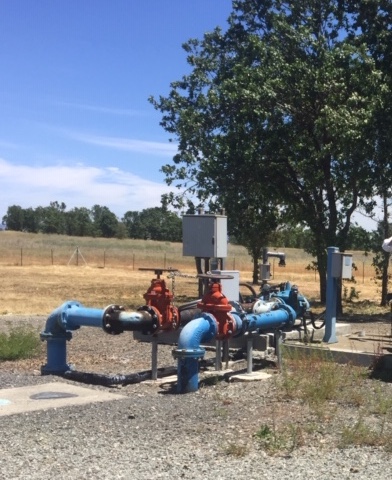 The Santa Rosa Plain Drought Resiliency Project would provide water to Sonoma Water customers by re-establishing the functionality of a groundwater production well in the Santa Rosa Plain. In addition, the project could help drought-impacted well owners whose water sources have dried up.
The Santa Rosa Plain Drought Resiliency Project would provide water to Sonoma Water customers by re-establishing the functionality of a groundwater production well in the Santa Rosa Plain. In addition, the project could help drought-impacted well owners whose water sources have dried up.
Through a policy known as "conjunctive use," Sonoma Water increases its use of groundwater during droughts to offset declines in surface water. During wet or normal water years, Sonoma Water reduces groundwater use to allow aquifers to recover. Increasing water conservation efforts during droughts is a third component of conjunctive use.
The project will also add recharge capacity for at least one of the production wells. This will allow the well to work in reverse. Instead of pumping water out of the ground, the well will receive treated, high-quality drinking water when it’s plentiful. The water will be stored in underground reservoirs known as aquifers. This water will recharge the aquifer and will be available for use during future droughts and emergencies.
Frequently Asked Questions: Santa Rosa Plain Drought Resiliency Project
What is the purpose of the Santa Rosa Drought Resiliency Project?
The Santa Rosa Plain Drought Resiliency Project has several goals, including:
- Providing emergency water to people whose water sources have dried up;
- Providing additional drinking water to cities and water districts in the North Bay, as they reduce reliance on Russian River water during this unprecedented drought period; and
- Adding the capability to recharge the Santa Rosa Plain basin with winter/spring water to ensure that sustainable groundwater conditions are maintained and to provide increased resiliency during future droughts or other emergencies.
What is the Santa Rosa Drought Resiliency Project?
This two-phased project will do the following:
- Phase 1 consists of upgrading the water treatment at Sonoma Water’s Todd Road groundwater production well in the Santa Rosa Plain. The upgrade is needed to comply with new water quality regulations. This well began producing water on Oct. 7, 2021. The well produces 1.4 million gallons of water a day. This supplemental water supply augments Russian River supplies provided by Sonoma Water for delivery to its customers for domestic and public water supply needs, fire flow protection, and in some cases to support health and safety and livestock needs in areas experiencing severe water shortages.
- Phase 2 will consist of:
- Upgrading the water treatment and piping for the other two wells so they can be used during extreme droughts or times of emergency (for example, earthquakes); and
- Adding recharge capabilities to one of Sonoma Water’s three wells (or constructing a new recharge aquifer storage and recovery [ASR] well). This step will allow the Santa Rosa Plain groundwater basin to be recharged with drinking water from the Russian River during winter and spring (when it's plentiful) to replace water pumped during the emergency. This water will be stored underground until it’s needed.
The initial activities of Phase 2 will be to develop the details of the project components in order to apply for emergency drought funding opportunities. The ASR project requires planning, design, permitting and funding. In response to the severe drought conditions, Sonoma Water is initiating the planning portions of Phase 2 now to determine the information needed to design the project, address permitting requirements, and pursue funding opportunities.
Why is Sonoma Water proposing to use groundwater wells during a drought?
The three Santa Rosa Plain production wells – which were originally drilled in 1977 in response to the historic 1976-77 drought – are a critical component of the regional drought and seismic emergency water shortage resiliency strategy.
Known as conjunctive use, this strategy increases groundwater use during dry years while relying more heavily on Russian River water during wet and normal years. Conjunctive use allows the groundwater aquifers to recover and recharge during wet years. To that end, the production wells were last relied upon during the 2012-2015 drought years when they provided an average of 766 acre-feet per year to help reduce Russian River water usage during those dry years.
Since 2015 the wells have primarily been offline and averaged only 20 acre-feet of production each year, allowing the local aquifer system to fill back up and be ready to help us get through future dry times like now. For comparison purposes, Sonoma Water delivers an average of about 45,000 acre feet of Russian River water to its customers.
Where are the production wells located?
All three Sonoma Water production wells are located in the Santa Rosa Plain. One is near Sebastopol Road, one is near Todd Road and one is near Occidental Road.
Will pumping from the Santa Rosa Plain groundwater wells affect the well that I use for my home?
Most home wells are connected to the shallower aquifer in the Santa Rosa Plain Basin. Sonoma Water’s production wells are deep (500 feet to 1,060 feet), and draw water from the deep aquifer, not the shallower aquifer. Monitoring from Sonoma Water’s network of 18 monitoring wells during the last drought period when the production wells were more consistently in use found that shallower wells weren’t affected by the pumping.
How will pumping from the Santa Rosa Plain production wells affect the city of Sebastopol’s wells?
During previous time periods when Sonoma Water’s Santa Rosa Plain production wells were in more consistent use, no impacts to the City of Sebastopol’s wellfield is known to have occurred. This includes a time period from approximately 1999 to 2009 when pumping from Sonoma Water’s wellfield averaged approximately 3,600 acre-feet each year.
Will pumping from the Santa Rosa Plain production wells affect the Laguna de Santa Rosa?
Creeks, streams, and the Laguna de Santa Rosa are connected to the shallower aquifer. Sonoma Water’s production wells are deep, and draw water from the deep aquifer, not the shallower aquifer. Because groundwater-levels in the shallow aquifer system (which is connected to surface water sources like the Laguna de Santa Rosa) are not anticipated to be impacted by drought year pumping from these wells, streams and associated habitats are not expected to be affected.
What is Aquifer Storage and Recovery (ASR)?
As proposed in this project, Aquifer Storage and Recovery would store treated, high quality surface water in underground reservoirs, known as aquifers, during wet periods when Russian River water is plentiful. The stored water can be used in summer months or during droughts. ASR is a common water management strategy employed in California, the United States, and the world to increase water supply reliability.
When will the ASR project be up and running?
In 2013, Sonoma Water, and local partners conducted a feasibility study for a regional groundwater banking program that would store surplus Russian River water produced at existing drinking water facilities in aquifers beneath the Santa Rosa Plain or in Sonoma Valley. Sonoma Water and the City of Sonoma piloted a successful, small-scale ASR project in 2018-2019.
- The feasibility study and the pilot project found that ASR is possible, but before the Santa Rosa Plain ASR project is operational, Sonoma Water must:
- Conduct tests to monitor any potential water quality changes and the local aquifer’s hydraulic response to recharge;
- Receive a permit from the North Coast Regional Water Quality Control Board; and
- Make changes to at least one of the existing production wells (or drill a new ASR well) to allow water to be sent into the ground (rather than being pumped out).
The types of information that is needed include assessment of the water quality compatibility of the recharge water and the native groundwater, evaluation of equipment and operational changes needed for the well, focused evaluation of the local aquifer systems, and potential impacts to nearby wells. Data collection for the planning phase will likely include design and permitting of a short-term pilot-scale demonstration test, which allows for incremental testing of the technology prior to operating at full-scale.
The completion schedule for Phase 2 will depend upon the outcome of the planning work and identification of funding sources to complete the planning, design, permitting, construction and operational components of the project.
